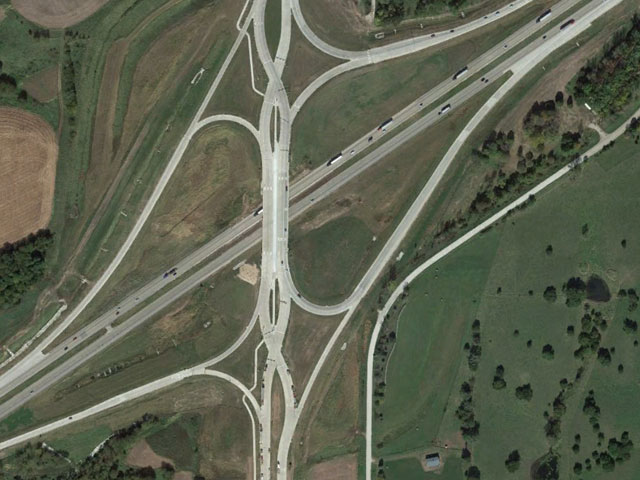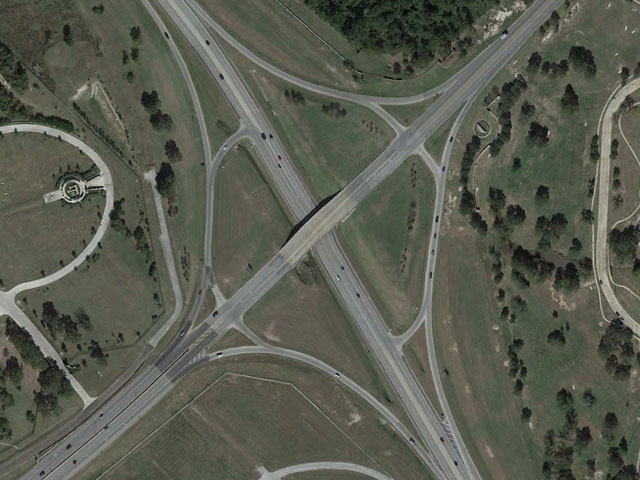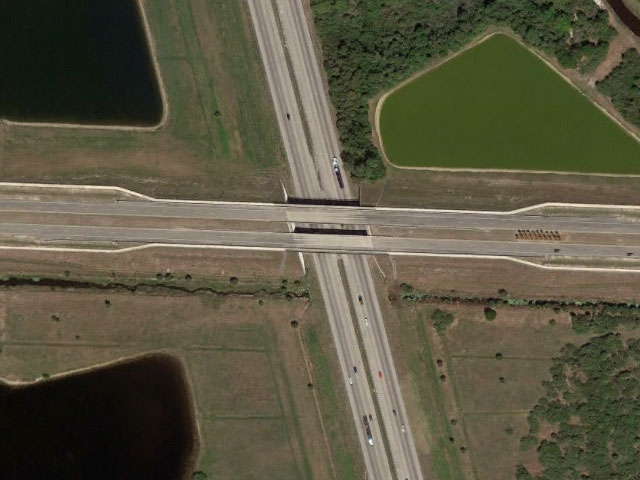Note: This article is not specifically about the diverging diamond interchange, but raises another topic related to innovative geometric interchanges.
There are some topics in the transportation world that are just not dared to be brought up. For the past several decades, even the mere mention of considering left exits or entrances on highways, would send shivers down the spines of transportation engineers. Engineers and planners have been trained to avoid considering left exits as if lightning would strike if them if they did. Realizing that I am putting my life at risk by possibly angering the transportation gods, I would like to revisit this topic and show why we may want to take a closer look at left exits again.
The first question to ask is why do transportation engineers hate the left exit concept? There are several valid reasons. Here are the five biggest issues with left side ramps:
- Driver Expectancy – The way we have designed highways have trained drivers that interchange ramps are almost always on the right side of the road. Therefore, the theory goes that left side ramps cause some drivers to either miss their exit or not expect merging traffic from the left side.
- Heavy Lane Shifting – When a ramp is on the left side of the road it can be affected by an interchange upstream or downstream of that ramp with right side ramps. Drivers may be required to weave through all the lanes of the highway to get to the next exit. Depending on the distance between the ramps, this can cause serious weaving concerns.
- High Speed Merging – A merge or diverge on the left side of the highway means that there will be weaving with traffic in the “fast lane”, which tends to have the more aggressive drivers on the road. Ramp traffic will have a full range of drivers with different levels of aggressiveness, which could lead to a bad mix of drivers in the left lane.
- Safety – The new Highway Safety Manual suggests that there is likely to be 49% more crashes with left ramps compared to other ramps. Avoiding left side ramps would seem to be a safe choice.
- Future Widening – The argument goes that widening for additional lanes on a highway in the future is much easier if all the exit ramps are on the right side. The widening can simply be added to the left of the existing lanes.
All of these issues are valid concerns and will be addressed shortly. But before we do, let us look at some of the positive features of left side ramps.
- Cost Savings – Left exits can easily save $50-$100 Million (or more) on a construction project for major interchanges. The reason is that left exits are more direct than right exits, which means less land is needed for the interchange as a whole and expensive fly-over ramps with long bridges can be avoided.
- Lane Balancing – When all ramps are on the right side of the highway, it requires a heavier load of traffic in the right lanes of the highway. When an interchange has a high volume of traffic using the ramps, this can cause delays on the entire highway due to the heavy weaving needed that slows traffic down. When left ramps are introduced, traffic can be more evenly distributed among all the lanes of the highway, which can improve overall traffic flow.
- Thru Lane Continuity – When there is a high volume of traffic for the off-ramps, it is often necessary to peel one of the thru lanes of the highway into the ramp. For instance, suppose 1,500 vehicles/hr want to go onto a westbound ramp and another 1,500 vehicles/hr want to go onto an eastbound ramp. If, as suggested by the AASHTO Policy on Geometric Design (the Green Book), we have one ramp on the right for both movements, followed by a split on that ramp, we would require at least two lanes of traffic on the initial off-ramp. For smooth traffic flow, this would likely require one of the thru lanes on the highway to be peeled off to the ramp. If a left exit were introduced for one of those movements, no consideration would be needed to convert a highway thru lane into a ramp lane.
- Elimination of Weaving Concerns within the Interchange – The simplest interchange form which requires no intersections within the interchange is the full cloverleaf. But the cloverleaf is an inefficient and often unsafe form due to the short weaving concerns. Many cloverleaf interchanges are being converted into other interchange forms to eliminate the weaving. Left side ramps are very efficient at avoiding weaving issues within the interchange.
Looking at the positive features of left side ramps shows that there are some valid reasons for consideration. The next question is can we overcome the negative features of left side ramps or at least mitigate the issues?
The first issue that we mentioned was driver expectancy. How real is this issue now? Local traffic will know where the left side ramps are. Many drivers not familiar with an area will now either use a GPS device in their vehicle or get directions off the internet, which will warn where left exits are in their route. Other new technologies in vehicles can also assist drivers now.
Some of the driver expectancy issues could also be due to inefficient signing strategies. Perhaps, we should reconsider how we warn drivers about left exits. Some possible thoughts include having a different background color on left exit signs, such as neon green, full yellow, or yellow diagonal striping in the direction of the ramp. Another suggestion is to add symbology to left exit warnings so that drivers will have a graphic image to reinforce the message of a left exit.
A final note on driver expectancy is that the whole concept is relative. When we built our highway system over a half century ago, we could have decided that all “left turning movements” would have left ramps. If we had decided on that, then there would be a driver expectancy to be on the left side of the road for left turning movements at interchanges just like there is a driver expectancy to be on the left side of the road for a left turn at an intersection. Driver expectancy is created by engineers and can be changed by engineers as well.
The second issue discussed was heavy lane shifting. This is a legitimate concern when two interchanges are closely spaced. When this happens, there are still ways to mitigate the weaving concern. A barrier can be placed in the highway that prohibits dangerous weaving from one ramp to the next. Drivers who would have made that weave but are now prohibited can be suggested an alternate route or be provided with an additional left side ramp to make the movement safely.
Left side ramps could provide a possible benefit by discouraging very short trips on the highway that can be done with the local network. Imagine if each interchange on a highway alternated with left side ramps and right side ramps with barriers between the interchanges that would prohibit drivers to weave between adjacent interchanges. This could improve the operations of the highway significantly and make better use of our full roadway network.
The third issue was high speed merging. The argument goes that most of the aggressive drivers are in the left lane, which will create safety issues. This brings up some fundamental questions. Do engineers implicitly promote aggressive driving by the design of our freeways? Do we really want speeding in certain lanes? Should we have different speed limits in each lane of a highway? If adding left side ramps would slow traffic in the “fast lane”, would this be such a bad result? The safety issue here seems to be with the aggressive drivers. Should we be designing to separate the aggressive drivers with the non-aggressive drivers or should we be trying to eliminate aggressive driving? Perhaps this issue is overblown in the wrong direction.
The fourth issue dealt with safety. Having a 49% increased probability of crashes on left side ramps is definitely a concern. Should we just accept this as fact and avoid left side ramps or should we ask why do we have such a high rate of crashes and how do we try to improve the safety of left side ramps? No research has gone into the possible reasons why left ramps are unsafe. And the reality is that we still have many left side ramps that are cost prohibitive to convert to right side ramps.
There is no guidance on how to design left side ramps, so most of the ramps are designed and built using right side ramp guidance. But the design needs to be different. The driver’s perspective is different in his or her vehicle because that driver is on the left side of the vehicle. His or her blind spot in the side mirror can be different on the left side than on the right side. The fear of a crash could play a factor as well. On a right side on-ramp, a driver may be more cautious merging into a highway since a crash would be on the driver’s side of the vehicle. These topics need further research to help understand how to design left side ramps more safely.
The last negative issue with left side ramps mentioned dealt with future widening of the highway. In many urban areas where widening is more commonly needed, the widening needs to be on the outside lanes due to not having enough room to widen on the median side. In cases where inside widening is possible, left side ramps can be adjusted just like right side ramps are adjusted for outside widening. And just like right side ramps, left side ramps can be initially designed to take into account possible future widening.
One last thought into why we need to look into researching left side ramps. Although engineers claim that they hate left side ramps, more and more left side issues are being developed. Managed lanes on highways are now requiring more left side ramps being built for managed access. In places where managed lanes are only for limited hours, this can create a full interchange with left side ramps.
Additionally managed lanes in general have characteristics of left side ramps. They are located on the left side of the highway. Concurrent managed lanes mix traffic from the “fast lane” with managed lane traffic that can have varying degrees of aggressiveness. Separated managed facilities have on and off ramps or weaving areas with the highway on the left side. To claim that managed lanes are good while left side ramps are bad seem to be conflicting statements.
We also need to find ways to improve our existing left side ramps. There are existing left side ramps across the country that have lower crash rates that we can learn from. This will allow us to make improvements on the left side ramps with high crash rates. Perhaps with this additional research on left side ramps, we will be able to find new efficient ways to improve our highway system.





